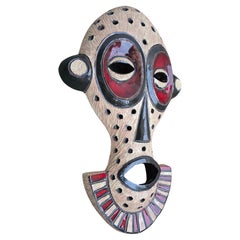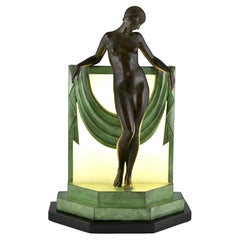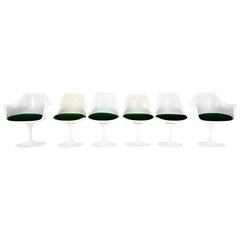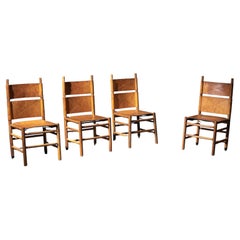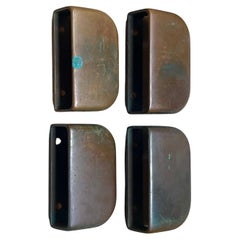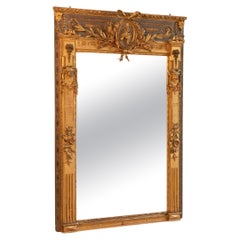Belgium
to
2,062
1,007,632
704,526
15,155
8,155
5,858
4,190
3,954
2,628
2,517
1,952
1,467
1,418
1,223
815
729
645
528
347
303
299
272
262
256
222
205
120
107
100
90
85
85
77
44
35
30
29
18
16
15
12
8
6
6
6
5
5
4
3
3
2
2
2
2
1
1
1
1
1
277
233
218
191
183
Handcrafted Ceramic Tribal Mask
Located in Antwerp, BE
Handcrafted Ceramic Tribal Mask – Signed “Atelier Manteln – BAKU 74” – Kuba/Songye Inspired
This unique ceramic mask is a striking and expressive piece of studio art, crafted in 197...
Category
Mid-20th Century Belgian Belgium
Materials
Ceramic
Art Deco Style Lamp Nude with Scarf by Fayral for Max Le Verrier Séréntité
By Max Le Verrier, Pierre Le Faguays
Located in Antwerp, BE
Art Deco style lamp sculpture nude with scarf SERENITE signed Fayral, pseudonym of Pierre Le Faguays.
Patinated metal on marble base, frosted glass.
Design ca. 1930.
Posthumous cont...
Category
2010s French Art Deco Belgium
Materials
Marble, Metal
Tulip Dining Chairs by Eero Saarinen for Knoll International, 1970s, Set of 6
By Knoll, Eero Saarinen
Located in bruxelles, BE
Set of 4 chairs and 2 armchairs in fibreglass, aluminium and green fabric. The chairs turn but the armchairs do not. Stamped Knoll. Seat height: 47 cm. Armchair width: 67 cm. Wear du...
Category
1970s Central American Mid-Century Modern Vintage Belgium
Materials
Aluminum
Kentucky Chairs by Carlo Scarpa for Bernini, Italy, 1980s
By Bernini, Carlo Scarpa
Located in Antwerp, BE
Original Kentucky chairs designed by Carlo Scarpa for Bernini, 1970s. Each featuring a cylindrical walnut wood frame, brown leather seat and back, and burnished brass ferrules on the...
Category
1980s Italian Mid-Century Modern Vintage Belgium
Materials
Leather, Walnut
Finish bronze door handles series of 4 all original + patina midcentury heaven
By Erik Gunnar Asplund, Alvar Aalto
Located in Forest, BE
Lovely series of 4 massive bronze casted door handles. They could be used inside or outside.
________________________________________________________
Son travail comprend également l...
Category
1950s Finnish Mid-Century Modern Vintage Belgium
Materials
Bronze
19th century ancient baroque mirror with floral and animal decorations
Located in Oostende, BE
Monumental mirror with exquisite details. The mirror has been restored and is in excellent condition.
Category
19th Century French Baroque Antique Belgium
Materials
Mirror
Bernhardt & Vella Pair of 'Alba' Freestanding Ceiling Fixed Bookcases for Arflex
By Arflex, Bernhardt & Vella
Located in Tilburg, NL
Ellen Bernhardt and Paola Vella for Arflex, 'Alba' Sectional Freestanding Ceiling Fixed Bookcase.
This is a wonderful and very versatile freestanding bookcase with many possibilitie...
Category
21st Century and Contemporary Italian Mid-Century Modern Belgium
Materials
Metal
John Galliano black jacquard pattern lurex knit spaghetti straps top
By John Galliano
Located in Antwerpen, Vlaams Gewest
This elegant black lurex top embodies the timeless charm of a classic John Galliano design. Featuring spaghetti straps and a flattering fit, it exudes sophistication. The jacquard pa...
Category
1990s Italian Belgium
Flavio Poli Seguso Murano Red Yellow Sommerso Art Glass Vase
By Flavio Poli, Murano Glass Sommerso
Located in Linkebeek, BE
Flavio Poli Seguso Murano Red Yellow Sommerso Art Glass Vase
Colors - Decoration - Murano Glass
Designed by Flavio Poli and manufactured by Seguso Vetri d'Arte. Italy, 1950s.
Measure...
Category
20th Century Italian Mid-Century Modern Belgium
Materials
Art Glass
Vintage Couple MTC Brass Cranes Ibis Design Bird Regency 32cm
Located in Poperinge, BE
Beautiful pair of vintage brass cranes or ibises on a round base, Hollywood Regency style from the 60s-70s, pristine vintage items to style your interior.
In perfect vintage conditi...
Category
1960s Indian Hollywood Regency Vintage Belgium
Materials
Brass
'All over the shop'
By RICHARDSON RAY
Located in Paris, FR
Ray Richardson is a contemporary British artist known for his cinematic paintings. The artist employs icons of working-class London, including bull terriers, soccer pitches, and grit...
Category
Early 2000s Realist Belgium
Materials
Pencil
Green bouclette Alky chairs by Giancarlo Piretti for Anonima Castelli
By Anonima Castelli, Giancarlo Piretti
Located in Brussel, BE
Green bouclette famous Alky chairs by Giancarlo Piretti for Anonima Castelli. 2 available.
Category
1960s Italian Mid-Century Modern Vintage Belgium
Materials
Metal
Chinese Guanxu Porcelain Teapot Marked And from the period (1875-1908)
Located in Bilzen, BE
Antique Chinese porcelain teapot with fine hand-painted decoration, 6-character mark of Guangxu from the period (1875-1908)
Perfect condition, no chips, cracks or other defects
Tota...
Category
Late 19th Century Chinese Qing Antique Belgium
Materials
Porcelain
Vintage Decorative gramophone horn in wood
Located in Linkebeek, BE
Decorative gramophone horn in wood
Antique - Decoration - Phonograph
Materials : Wood - Metal
Wear consistent with age and use : See photos please
Category
20th Century Industrial Belgium
Materials
Metal
Lounge Chair by Fåtölj Yngve Ekström
By Yngve Ekström
Located in Antwerpen, BE
Yngve Ekström Lounge Chair – Sweden, 1960s
A rare and characterful lounge chair designed by Yngve Ekström, a key figure of Scandinavian modernism. This particular version features a ...
Category
Late 20th Century Swedish Scandinavian Modern Belgium
Materials
Pine
Neo-Gothic Religious Triptych of “Mary of Perpetual Help”
Located in Meulebeke, BE
Belgium / 1890 / Religious Triptych / wood, paper, glass / Neo-Gothic / Antique
very old framed icon print under glass, patina
handgeschilderde panelen op de zijkant
Fabulous Late ...
Category
Late 19th Century Belgian Gothic Revival Antique Belgium
Materials
Glass, Wood, Paper
16th Century Mary Magdalene in Polychromed Carved Walnut
Located in Meer, VAN
Mary Magdalene in Polychromed Carved Walnut 16th Century
Devotional figure in carved wood, depicting Mary Magdalene. Walnut, most probably Flemish and from the 16th century.
It de...
Category
16th Century European Medieval Antique Belgium
Materials
Walnut
Are we human (or are we dancers)? - Polaroid, Women, 21st Century, Nude
By Kirsten Thys van den Audenaerde
Located in Morongo Valley, CA
Are we human (or are we dancers)? - 2020
50x50cm,
Edition of 7 plus 2 Artist Proofs,
Archival C-Print based on the Polaroid.
Signed on the back and with certificate.
Artist inven...
Category
2010s Contemporary Belgium
Materials
Archival Paper, Photographic Paper, C Print, Color, Polaroid
Antique Swedish Wooden plates 1800's Handmade Folk Craft great series
Located in Forest, BE
Swedish antique birch hand made wooden plates. Made to be used as a dining plates. Fine quality of handwork. these are true piece from the early 19 century. Beautiful patina on the ...
Category
Early 19th Century Swedish Folk Art Antique Belgium
Materials
Birch
Guillerme et Chambron, a pair Oak Armchair Edited by Votre Maison 1970
By Votre Maison, Guillerme et Chambron
Located in Mouscron, WHT
Guillerme et Chambron, two Oak Armchair Edited by Votre Maison 1970
price is for one
two are available
Votre maison : a style, a concept, a mindset.
The Votre Maison story begins...
Category
1970s French Mid-Century Modern Vintage Belgium
Materials
Oak
Masterplan - Contemporary, Nude, Women, Polaroid, 21st Century
By Kirsten Thys van den Audenaerde
Located in Morongo Valley, CA
Masterplan - 2021 -
20x20cm, Edition of 7 plus 2 Artist Proofs,
digital C-Print based on a Polaroid,
Not mounted. Signed on the back and with certificate. Artist inventory PL2021...
Category
2010s Contemporary Belgium
Materials
Archival Paper, Photographic Paper, C Print, Color, Polaroid
19th century Spanish 4doors cabinet ...
Located in Brecht, BE
a unique piece of furniture, 4doors cabinet from the Pyrenees region in the north of Spain ... lovely sculpted panels ... pure and genuine as I love ...
Category
Mid-19th Century Spanish Antique Belgium
Materials
Chestnut, Oak
20th century French bistro table with cast iron base and oak top
Located in Meulebeke, BE
Beautiful early 20th Century French bistro table. This table has a rectangular top made of solid oak wood and a cast iron base with decorative old layers of cream colored and weather...
Category
Mid-20th Century French Mid-Century Modern Belgium
Materials
Iron
Vintage marble coffee table, 1970s
Located in Leuven, Vlaams Gewest
Staggering marble coffee table with the most beautiful natural vaining we've ever seen on any table.
A mixture of green, grey and beige tints create a fantastic looking table.
beau...
Category
1970s Italian Mid-Century Modern Vintage Belgium
Materials
Marble
Set of 6 Vintage Luminarc Vins Moselle Wine Glasses Green
By Luminarc
Located in Poperinge, BE
Vintage set of 6 Luminarc Alsace wine glasses with the inscription 'Vins Moselle' on the foot, large glasses with a narrow dark green foot, they have a capacity of just over 150ml, m...
Category
1970s French Vintage Belgium
Materials
Glass
Art Deco Model "Voltaire" Extandeble Dining-Table Designed by the Coene, Belgium
By De Coene Frères
Located in Antwerp, BE
Dining table by De Coene Frères chairs, model Voltaire, featured in original catalogue as the number 03-81-689. The table is made from Iroko woo...
Category
1940s Belgian Art Deco Vintage Belgium
Materials
Brass
$4,966 Sale Price / item
20% Off
High Sideboard designed by Cees Braakman for Pastoe, Serie CU 04
By Cees Braakman, Pastoe
Located in Antwerp, BE
Rare beautiful high sideboard designed by the Dutch designer Cees Braakman for Pastoe, a sideboard from the Japanese series CU 04 made in teak with a warm color. Features with harmon...
Category
1950s Dutch Mid-Century Modern Vintage Belgium
Materials
Metal
1910's Dutch Modernism Design Amsterdam School Dining Chair set
Located in Oud-Turnhout, VAN
Vintage very Rare early Dutch Modernism Design Amsterdam School Dining Chair set of 4. Made in the Netherlands, Amsterdam, 1910 / 1920's period. Solid...
Category
1910s Dutch Other Vintage Belgium
Materials
Fabric, Oak
$6,112 Sale Price / set
20% Off
Bamboo Coffee Table by Axel Vervoordt, Belgium, 1980s
By Axel Vervoordt
Located in Antwerp, BE
Coffee table by Axel Vervoordt, a visionary Belgian decorator and art dealer. Crafted in the 1980s, this exceptional piece showcases Vervoordt's unparalleled design prowess. Construc...
Category
1980s Belgian Mid-Century Modern Vintage Belgium
Materials
Bamboo
Belgian Art Deco Marble Fireplace Surround Black And Belgian Ardenne Marble
Located in Beervelde, BE
Typical Belgian Art Deco period, early 20th century, marble fireplace surround in perfect condition. The combination of the Black Belgian Marble and brown Belgian D'Ardenne marble ar...
Category
Early 20th Century Belgian Art Deco Belgium
Materials
Marble, Belgian Black Marble
Vintage 1990s Gianni Versace striped black wool/silk & leather detail suit
By Gianni Versace
Located in Antwerpen, Vlaams Gewest
Vintage 1990s Gianni Versace purple striped black suit. made in a mix of 57% wool 42% silk & 2% elastane and leather details at the back/sleeves/collar and the waistband of the trous...
Category
1990s Italian Belgium
Crystal Mix Set of 6 Cobalt Stem Glasses with Overlay Cut to Clear
By Nachtmann
Located in Verviers, BE
Vintage set of 6 cut to clear crystal stem glasses.
Mix crystal (Bleikristall 24% Mundgeblasen Handgeschliffen) glasses
Clear demi crystal glass. Side facetted and toothed stem.
Th...
Category
1950s German Mid-Century Modern Vintage Belgium
Materials
Crystal
Arteluce Atomic Space Chrome Disk Lamp Mira "C" Designed by Ezio Didone
By Ezio Didone, Arteluce
Located in Antwerp, BE
Vintage midcentury Arteluce saucer lamp.This Mira C Suspension provides diffused upward and downward light and features aluminum chrome lamp body finish a sandblasted, acid-etched gl...
Category
1980s Italian Mid-Century Modern Vintage Belgium
Materials
Aluminum
$1,050 Sale Price / item
20% Off
Bertil Vallien Rare Wrought Iron Fire Screen, circa 1960, Sweden
By Bertil Vallien
Located in Brussels, BE
Beautiful and rare Bertil Vallien wrought iron fire screen.
Boda edition, circa 1960, Sweden.
Rare piece on the market, very poetic and decorative object.
Good original condition.
He...
Category
1960s Swedish Mid-Century Modern Vintage Belgium
Materials
Wrought Iron
Stunning colorful Mah Jong Missoni fabric by Hans Hopfer for Roche Bobois France
By Roche Bobois
Located in Buggenhout, Oost-Vlaanderen
This big, stunning & colorfull Mah Jong sofa by Hans Hopfer is a timeless masterpiece in the Roche Bobois collection, embodying both modularity and artistic expression. Originally de...
Category
Mid-20th Century Mid-Century Modern Belgium
Materials
Fabric
Chinese Carved white jade disc with openwork decoration on a wooden base, Qing
Located in Bilzen, BE
Antique 19th century Chinese disc carved in white jade on its original carved wooden base.
Qing period
In very good condition, diameter of the jade 5.5 ...
Category
19th Century Chinese Qing Antique Belgium
Materials
Jade
French Ceramic and Bronze Vase by Clement Massier
Located in Antwerp, BE
Large glazed vase by Clement Massier. Impressed maker's mark.
Clement Massier, Juan (AM)
Measures: Height 82 cm, width 35 cm, depth 28 cm.
Weight 12 kg.
Category
Mid-20th Century French Hollywood Regency Belgium
Materials
Bronze
Phillips Pendant Lamp with a Opaline Shade and Fittings, 1930s
By Phillips Holland
Located in Verviers, BE
From the range Phillips this centre-light is on a Flex Cabele 60 cm
The lamp has a fitting on a Solid plate and holds a shade of opaline glass.
Size Schade: 30 cm Diameter. / Height...
Category
1930s Dutch Art Deco Vintage Belgium
Materials
Blown Glass
Vintage Green Crystal Bowl Val Saint Lambert 1960s
Located in Poperinge, BE
Beautiful vintage green crystal bowl, fruit bowl or vide poche by Val Saint Lambert, early 60s, Belgium, marked at the bottom in the base.
Val-Sain...
Category
1960s Belgian Vintage Belgium
Materials
Crystal
Serpentine Green Marble Sculpture, The Lion Of Lucerne
Located in Honnelles, WHT
Serpentine Green Marble Sculpture, The Lion Of Lucerne After Bertel Thorvaldsen Circa 1880
Category
19th Century French Louis Philippe Antique Belgium
Materials
Marble
La Cascade - 20th Century, Surrealist, Lithograph, Figurative Print
By (after) René Magritte
Located in Sint-Truiden, BE
Color lithograph after the 1961 oil on canvas by René Magritte, printed signature of Magritte and numbered from the edition of 300.
The lithograph features the dry stamps of the Mag...
Category
20th Century Surrealist Belgium
Materials
Lithograph
pair of lounge seats by Mobiltecnica Torino
Located in Diest, BE
Pair of lounge chairs by Mobiltecnica Torino, Italy 1970's
Category
1970s Italian Mid-Century Modern Vintage Belgium
Materials
Chrome
$1,432 / set
Mid Century Murano Glass Bull Sculpture Statue Somerso Glass Art
Located in Poperinge, BE
Mid Century Murano Bull, Italian Somerso glass art, clear Murano glass with gold flakes and a central blood red and cobalt blue accent, circa mid 20th cent...
Category
Mid-20th Century Italian Belgium
Materials
Murano Glass
Beautiful set of early 1900s surgical instruments, including an amputation saw s
Located in Leuven , BE
Beautiful set of early 1900s surgical instruments, including an amputation saw stamped A. GOUGEON and a complete Renault trepan with its accessories (rare). Overall in good condition...
Category
Late 19th Century French Antique Belgium
Materials
Metal
Peregalli and Calatroni Post Modern Armchair, circa 1985, Italy
By Maurizio Peregalli
Located in Brussels, BE
Post-modern Maurizio Peregalli and Sergio Calatroni chair, edited by Zeus circa 1985, Italy.
Poltrona model.
Black powder-coated square steel tube, bl...
Category
1980s Italian Post-Modern Vintage Belgium
Materials
Metal
Artist Made Ceramic Tile Side Table, 1960's Belgium
Located in Oud-Turnhout, VAN
Handmade Artist made Ceramic Tile Side table. Made in Belgium, 1960's period. Brutalist in design and style. Studio Pottery made ceramic tiles with pale blue lightning bolt design on...
Category
1960s Belgian Brutalist Vintage Belgium
Materials
Steel
'Mole' Lounge Chairs by Sergio Rodrigues, Brazil, 1950s
By Sergio Rodrigues
Located in Antwerp, BE
Designed by Sergio Rodrigues in 1957, these iconic Mole lounge chairs embody the essence of Brazilian mid-century modernism. Featuring solid rounded jacara...
Category
1950s Brazilian Mid-Century Modern Vintage Belgium
Materials
Leather, Wood
Console Sidetable Reclaimed Walnut and Iron
Located in Vosselaar, BE
Our BOX console of a 19th century Italian one slab walnut plank on a custom made iron, dark bronze finished, stand.
Category
2010s Belgian Belgium
Materials
Iron
Vintage Italian Wooden Globe Bookends Mercurio D’oro
Located in Poperinge, BE
Vintage set of wooden bookends in the shape of a classic globe, globe with protractor, made of wood, hard cardboard and paper, at the bottom the maker's sticker of Mercurio D'oro 'Ma...
Category
1970s Italian Vintage Belgium
Materials
Wood
Paris – Montmartre, Charles Verbrugghe, Bruges 1877 – 1974 Paris, Signed
Located in Knokke, BE
Paris – Montmartre
Verbrugghe Charles
Bruges 1877 – 1974 Paris
Belgian Painter
Signature: Signed bottom left and placed Paris
Dimensions: Image si...
Category
20th Century Impressionist Belgium
Materials
Canvas, Oil, Panel
Art Deco Panther Sculpture by H. Gual France 1930
By H. Gual
Located in Antwerp, BE
Art Deco panther sculpture signed by H. Gual.
Patinated Art Metal on a hand carved Belgian Black marble base.
France 1930.
Category
Early 20th Century French Art Deco Belgium
Materials
Marble, Metal
Podium Sofa by Hauvette Madani
By Hauvette & Madani
Located in Antwerpen, BE
The Podium Sofa by HAUVETTE MADANI.
Handmade in Italy, the Podium Sofa is available in COM and is made to order.
HAUVETTE MADANI is a design studio f...
Category
21st Century and Contemporary French Belgium
Materials
Fabric
$15,460 / item
Vintage Fisheye Mirror
Located in Bastogne, BE
- Vintage Fisheye mirror
- Gilding on metal
- Circa 1970s
- Made in Belgium.
Category
1970s Belgian Mid-Century Modern Vintage Belgium
Materials
Metal
Floor-to-ceiling wall Unit in the style of Franco Albini, 1960s
By Franco Albini
Located in Uccle, BE
Floor-to-ceiling wall Unit in the style of Franco Albini, 1960s
Product details
Dimensions D: 40,5 cm H: 320 cm (125.98") W: 265 cm (104.33")
Category
20th Century Italian Mid-Century Modern Belgium
Materials
Wood
Senoufo African Folding Chair Fish Pattern on the Back Ivory Coast.
Located in Linkebeek, BE
African hand-carved wooden chair with a beautiful dark brown patina. This folding chair, made up of two pieces that fit together, is made from a single piece of West African cabinet wood. Also called a guard chair, this traditional African folding chair was once reserved for the African elite. Suitable for indoor or outdoor use, this African club chair features a carved fish design on the back.
ethnic...
Category
Early 20th Century African Brutalist Belgium
Materials
Wood
Vintage V&B Burgenland Blue Platter, Huge Serving Dish, Germany, 1940-50s
By Villeroy & Boch
Located in Bastogne, BE
Own a piece of history with this incredibly rare pair of vintage V&B Burgenland blue platters.
These massive serving dishes are a true testament to mid-century modern design, boasti...
Category
1940s German Mid-Century Modern Vintage Belgium
Materials
Porcelain
Tekna Flatspot 1 Trimless Citizen LED Recessed Downlight with Gold Color Finish
By Tekna
Located in New York, NY
Trimless recessed downlighter, for false and concrete ceiling.
Dimensions: cut out 83mm (81mm for concrete ceiling) - outside diameter 80mm - built-in height 150mm.
To connect to ext...
Category
21st Century and Contemporary Belgian Modern Belgium
Materials
Aluminum
Italian Murano Chandelier
Located in Antwerp, BE
Italian Murano chandelier.
Diameter:50 cm.
Height fixture:50 cm.
Total height with the chain is 95 cm.
Six E14 bulbs.
Category
Mid-20th Century Italian Hollywood Regency Belgium
Materials
Metal
Keith Haring for Villeroy & Boch, Tea Service
By Keith Haring, Villeroy & Boch
Located in Uccle, BE
Villeroy & Boch porcelain tea set, decorated with drawings by Keith Haring, produced in 1991.
Limited to 500 copies
Please note that the large serving dish...
Category
1990s German Post-Modern Belgium
Materials
Porcelain
Mid-20th Century, Hand Painted Iron Piggy Bank Sculpture
Located in Linkebeek, BE
Mid-Century Iron Piggy Bank Sculpture - Hand Painted carst Iron
Decoration - Mid Century - Piggy
This one-piece cast cast iron piggy bank stood in a butcher shop since the late 1950s...
Category
20th Century Belgian Industrial Belgium
Materials
Iron
